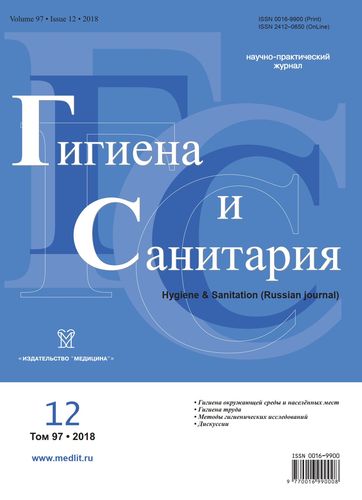Hygienic assessment of working conditions in radio-electronic component production
- Authors: Kiryanova M.N.1, Markova O.L.1, Ivanova E.V.1
-
Affiliations:
- North-West Public Health Research Center
- Issue: Vol 97, No 12 (2018)
- Pages: 1235-1238
- Section: OCCUPATIONAL HYGIENE
- Published: 21.10.2020
- URL: https://rjsocmed.com/0016-9900/article/view/640524
- DOI: https://doi.org/10.47470/0016-9900-2018-97-12-1235-1238
- ID: 640524
Cite item
Full Text
Abstract
Findings on the hygienic assessment of working conditions in radio-electronic component development and production at a modern enterprise producing capacitors, microcircuits, resistors and semiconductor devices are reported. Working conditions of employees engaged in radio-electronic component development (developers, designers) and production (photolithographers, wiremen, radio-electronic component and semiconductor device assemblers, adjusters and quality control inspectors) were studied. Hygienic studies of the working environment and working process factors were carried out to assess working conditions: workplace noise and magnetic field levels, microclimatic parameters, illuminance, the air pollution by chemicals. Time studies were performed to evaluate the heaviness and intensity of the work process. As a result of our studies, the main adverse factors were identified to assess worker health risks. Working conditions in job groups engaged in radio electronic component design were evaluated as harmful of 3 class, 1 degree. Working process intensity caused by sensory and mental load was found to be the major adverse factor. Working conditions in the job group engaged in experimental and small-scale production are characterized by exposure to “low-intensity factors”. Visual strain and fixed working posture are common for such jobs as radio electronic device wireman and quality control inspector using optical equipment in their work, which rates the heaviness of their working process as harmful working conditions. Our findings are intended to be used to define main harmful factors for the health risk assessment of radio component production workers, to carry out a comprehensive occupational health risk assessment, identifying job and long-term employment duration risk groups, to develop risk management measures. Our findings can provide a scientific rationale and contribute to the development of a complex of hygienic and preventive medical measures to be introduced into the practice of health protection service.
About the authors
Marina N. Kiryanova
North-West Public Health Research Center
Author for correspondence.
Email: mrn@ro.ru
ORCID iD: 0000-0001-9037-0301
Senior researcher, Department of complex hygienic assessment of physical factors of the North-West Public Health Research Center, Saint-Petersburg, 191036, Russian Federation.
e-mail: mrn@ro.ru
Russian FederationO. L. Markova
North-West Public Health Research Center
Email: noemail@neicon.ru
ORCID iD: 0000-0002-4727-7950
Russian Federation
E. V. Ivanova
North-West Public Health Research Center
Email: noemail@neicon.ru
ORCID iD: 0000-0001-9461-9979
Russian Federation
References
- Survey Study of the Branch «Portrait of Russian Radio Electronics», JSC «Central Scientific Research Institute “Elektronika”, published 20.12.2017.
- RF State Program “Development of Electronic and Radio Electronic Industry for 2013-2025 « Approved by № 2396-р. RF Government Executive Order of 15.12.2012.
- Borisov Yu., Kalin S., Nemudrov V. Role ofmicroelectronics design centers in the development of national radio electronic industry. Elektronnye komponenty. 2008; (10): 17-21.
- Markov A.S., Trunova I.G., Pachurin G.V., Shevchenko S.M. «Analysis and improvement of working conditions at a micro circuit assembly and wiring site. Mezhdunarodnyi Zhurnal Prikladnykh i Fundamental’nykh Issledovanii. 2016; 11 (6): 1023-7;
- Patutin V.N., Artamonova V.G., Kostyuchek D.F. Labour and Health of Reproductive Age Women Employed in Instrumentation Manufacturing Industry. Prevention Measures. SPb. 2001.
- G.Ya. Krupkin, Е.V. Ivanova, Kh.L. Rodriges. Air regime of precision and sterile technology buildings. Meditzina Truda i Promyshlennaya Ekologiya. 2003; (8): 17-21.
- Fedotov A.E. Clean rooms. problems. theory. practice. M.: Asenmco; 2003. Second edition.
- Dubeikovskaya L.S., Frolova N.M., Salangina L.I., Kir’yanova M.N. Labour and health of women engaged in lead-tin soldering processes. Materialy Konferentzii «Women Health and Problems of Female Labour Safety», SPb., June 2003: 93-6.
- In’kov A.P. Features of the design of ventilation and air conditioning systems for health facilities. Inzhenernye sistemy. 2002; 4: 24-32.
- Trofimov V.A., Stepanov V.V., Fedoseeva N.M., Lugovskii G.A. Hygienic aspects of working conditions in microelectronic equipment production. In: Voprosy Gigieny Trudav Radioelektronnoi Promyshlennosti. М., 1979: 8-15.
- Plekhanov V.P.Assessment of chronic overstrainof computer users depending on age and employment duration. Meditzina Truda i Promyshlennaya ekologiya. 2018; 5: 58-61.
- Sorokin G.A. Fatigue and Occupational Risks. SPb, Publishing House of Politekhnicheskii University. 2008.
- Ekberg K., Björkqvist B, Malm P, Bjerre-Kiely B, Karlsson M, Axelson O. Case-control study of risk factors for disease in the neck and shoulder area. Occup Environ Med. 1994 Apr; 51(4):262-6.
- Buckley JP, Hedge A, Yates T, Copeland RJ, Loosemore M, Hamer M, Bradley G, Dunstan DW. The sedentary office: an expert statement on the growing case for change towards better health and productivity. Br J Sports Med. 2015. Nov; 49 (21):1357-62. https://doi.org/10.1136/bjsports-2015-094618 Epub 2015 Jun 1. https://www.ncbi.nlm.nih.gov/pubmed/26034192
- Ushkova I.N., Mal’kova N.Yu., Pokrovskaja L.A. Removal of eye fatigue during visual-intensive work. Meditzina Truda i Promyshlennaya Ekologiya. 1999; (9): 14-15.
- Ushkova I.N., Malkova N.Yu. Prevention of musculoskeletal system diseases under static and dynamic hand loads and local vibration exposure. Meditzina Truda i Promyshlennaya Ekologiya. 2004; (12): 41-43.
- Ushkova I.N., Malkova N.Yu., Merkuryeva L.I. About preventive measures at work with the computer. EHkologiya cheloveka. 2005; (10): 61-64.
- Ushkova I.N., Malkova N.Yu. Low-intensity laser radiation in the prevention of visual fatigue. Vestnik Sankt-Peterburgskoj gosudarstvennoj medicinskoj akademii im. I.I. Mechnikova. 2007; 4: 58.
- Malkova N. Ju., Ushkova I.N., Soshnev I.V. Restoration of functions of sight at work with participation of the visual analyzer. Profilakticheskaya i klinicheskaya medicina. 2011. 3 (40): 291-292.
- Mal’Kova N.Y., Zhurba V.M. T. Meditzina Truda i Promyshlennaya Ekologiya. 2017; 9: 119-120.
Supplementary files









